DEFCON 17. Hacking 400,000 passwords, or how to explain to a roommate why the electricity bill has increased. Part 1
Greetings to all and thank you for making my presentation the final DEFCON conference this year. I really appreciate it and will try not to disappoint you. My name is Matt Weir, I am a graduate student at the University of Florida. Before we start talking directly about password cracking, I want to say that I work with a very good team and call its members right now. This is my leader, professor, Dr. Sidir Eggrvol, who put his hand to my presentation and Professor Brenot de Medeiros. I would also like to thank the National Institute of Justice and the National Center for Criminal Research "White Collars" for funding my research.
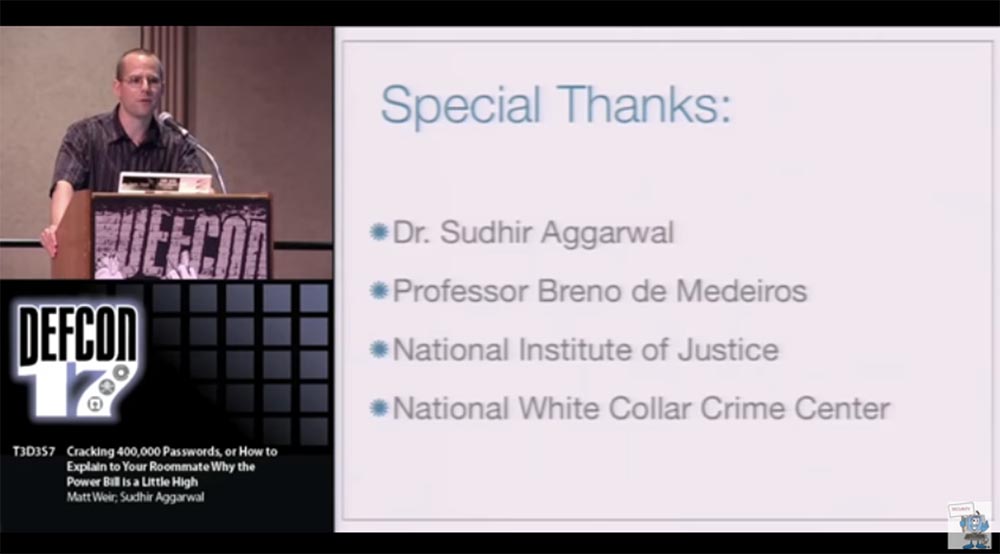
I really appreciate it, because this help has given my research some legitimacy. Because when I went to the scientific council to approve the topic of my research, I began the conversation with the fact that it was dedicated to cracking passwords. These words provoked an indignant reaction, so I had to explain that it was necessary in order, for example, to catch and bring to justice the molesters of minors and other such criminals.
')
Thus, the main purpose of my research is to help jurisprudence.
The law enforcement agencies are strong enough in encryption, so I was not going to help them with this, I just wouldn’t have enough brains for that. I decided to investigate the problems associated with attacks on users, because it is much easier than hacking complex ciphers. I wanted to develop a better model of how people create their passwords in real life, and then use it in an attack-resistant password strategy.
The first thing we need is to have an idea of how people create their passwords. We spent some time just to go online and find open password lists. They appear there for various reasons, for example, some hacker hacks the site and puts a list of user passwords to say to everyone: “look how cool I am”! We collected these passwords and analyzed.
There are many hackers forums, electronic bulletin boards and the like, where we also collected passwords. Now you rarely see simple text passwords, but this is a great thing, because all we have to do is just to find them and read them. However, most passwords are hashed, so in order to understand how people create them, we first need to crack them.
In fact, this is good for us, as it forces us to focus on practical goals. I mean, we just can’t just sit back and write research papers while drinking wine. We actually have to go ahead and try to apply what we got in our password lists, and check how it works. I was really interested in how to create an effective protection against hacking and to make passwords better, using more effective password creation strategies based on the knowledge gained from hacking.
I think it's much easier to hack something instead of fixing it. In this presentation I will try to avoid a detailed description of the tools and trifles I used. I'm not going to spend the next 50 minutes analyzing each command line of the J ohn the Ripper program, which serves to recover passwords for their hashes, or analyze page by page, how often people use sports team names as passwords. I do not want to waste your time.
If you are interested in details, you can visit my password-breaking blog www.reusablesec.blogspot.com or my website with my tools and documentation, which are freely available on the Internet at www.reusablesec.sites.google.com . Please leave your comments and feel free to say if you think we are doing something stupid. I really appreciate such comments, because this is the best way to evaluate the effectiveness of our work.
You also do not need to feverishly record anything or be afraid to skip some of the slides that flash on the screen, since this presentation is available on the conference CD, besides, you can download these slides from the Internet. I also recorded several additional tools on the disc. I’ll talk briefly about the tools used: this is our dictionary, created on the basis of the online version of RainbowCrack Tables , several password cracking scripts, analysis scripts that we used to analyze password lists and several user password lists we compiled.
It is noteworthy that we probably have the largest collection of single-line ASCII code encodings of passwords on the Internet. So you can say that my parents can be proud of me. I note that people create passwords even in this way, so that you can use it and hack them.
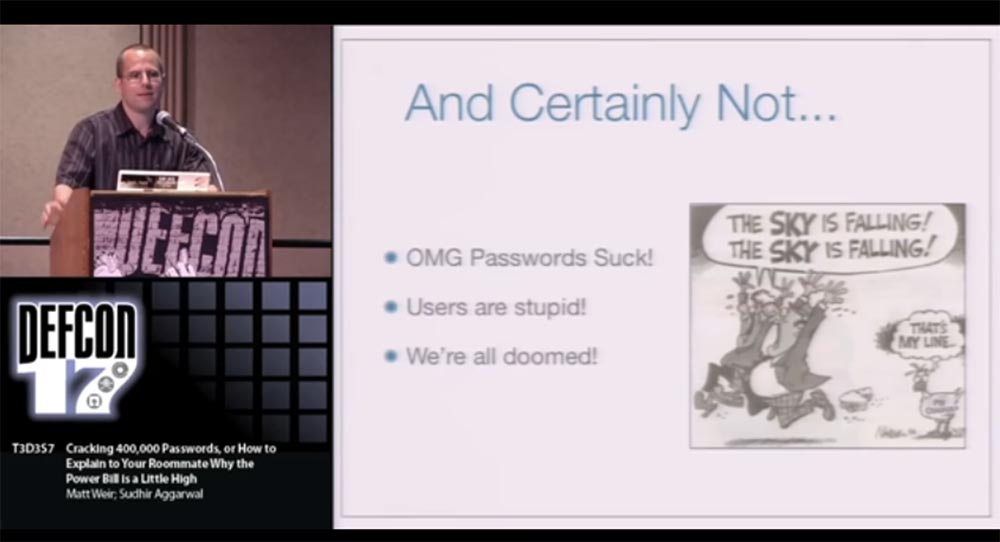
You can say, “Oh my God, passwords suck! Users are idiots, because they create stupid passwords, and in general, we are all doomed! ” Yes, I could spend time making fun of users, because it is fun, but not at all productive. I mean, we have known for many years that the fire is hot, the water is wet, that the user will simply choose a 1-2-3 password. This is not new. But we, as a security community, have to figure out what to do about it.
Not to say that I am an optimist, but I’m not too pessimistic about the future of passwords. I mean, we are “stuck” on these asterisks, which need to be filled in, and we will always use them, because they are really good.
There are many different factors that allow you to get rid of any "water", leaving only security. Password cracking becomes difficult, because people are beginning to use strong encryption, stronger password hashes, and passwords are more responsive to passwords. I think that is why there is such an interest in cracking passwords. I hope that Windows 7 will finally stick an aspen stake in the heart of XP , and we are starting to see fewer and fewer cases of using the WEP security algorithm for Wi-Fi networks, despite the fact that it is still quite widespread around. I mean, we should work on the problem of protecting passwords from hacking instead of destroying the existing system.
This approach will actually improve the situation, so I want to focus on what constitutes a password cracking session, what techniques are used and what steps need to be taken to crack password lists.
I want to focus on two different case studies. First of all, we created a password database for hacking using CISSP data - independent certification for information security. We collected many passwords everywhere, but these two sources, phpbb.com and webhostingtalk.com , were the best, because there were very large lists of passwords in the public domain.
Therefore, we first talk about hacking passwords from the phpbb.com list, and then about the results of hacking webhostingtalk.com . I will not arrange an introductory course in CISSP , because you know the language and terminology. After that, I will take a short break, and you can ask questions related to research using the TrueCrypt program, as well as talk about some passwords and non-standard passwords. So, let's talk about the basics of password cracking.

There are two different types of passwords and, accordingly, two ways to crack them, and they are very different from each other. The first is online passwords. You know from the films that you may not have access to the site at all if you do not know the password. Therefore, you are trying to get there by picking up various usernames and passwords. The main thing is that site creators try to protect themselves from hackers with the help of additional functions, for example, limiting the number of attempts to enter authorization data.
The second way is to hack offline passwords when you download a password hash and hack it on your computer. These are big problems in computer forensics, so you need to try to crack passwords before the police break in with an arrest warrant, kicking the door open with your feet. At the same time, they will remove the hard drive on which your program will be installed for hacking TrueCrypt along with cracked passwords. In addition, the cracking of passwords offline requires a very powerful computer and a lot of time.
In fact, after the attacker hacked the site and downloaded all the passwords and usernames, he is only limited by the time after which he can be caught.
The question is, why should a hacker crack passwords if he can just get full access to the site through a router. The answer is that people use the same password everywhere, so it's easier for you to access both email and bank account and PayPal account .
We did not do that. Having cracked passwords, we never used them for verification, for entrance on any site or in someone's account. I say this not because I believe that there are many federal agents in the audience here, but because this is really not good.
So, there are three different steps committed when a password is cracked. I want to differentiate them, because I will refer to them later. I had problems at each of these three stages.
The first stage concerns autonomous password cracking. Computer forensics assumes that you already have a password hash, in our case the entire hard disk of the computer was filled with this data. So, the first step you need to take is to try to guess what the user came up with for the password. To do this, you use the first attempt, suppose password123 . Then you hash it and get a set of letters and numbers 52F8A73082B1290 . In most cases, a simple and fast MD5 hashing algorithm is used . After that, you compare this set with your real user password hash, for example, 82503CA693453D1 . If it matched, you hacked the password. But since 52F8A73082B1290 ≠ 82503CA693453D1 , you try again and use the guess monkey123 . You repeat it again and again, until you get bored and you give up this thing.
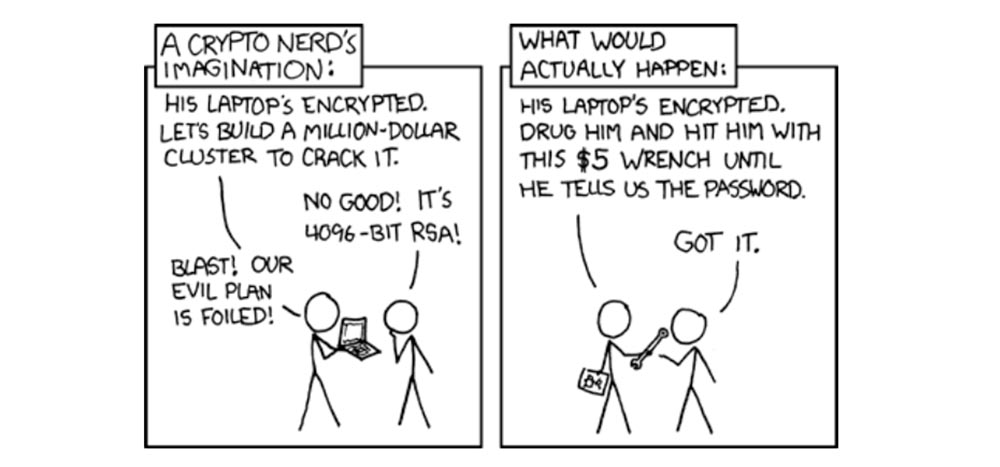
Left: as encryption experts imagine.
“His laptop is encrypted.” Let's create a million dollar decoder and hack it! ”
“It won't go, it's a 4096-bit cipher!”
- "Heck! Our criminal plan failed. ”
Right: as it usually happens.
“His laptop is encrypted.” Wash him and beat him with a five-dollar wrench until he tells us the password! "
- "I agree"!
Let's talk about the "highlights" in the passwords. This information is added to the password to complicate its hacking. It happens that two different people decided to use the same password. In this case, for example, you can add different usernames to the “defcon” password, in which case the hashes will be very different from each other.
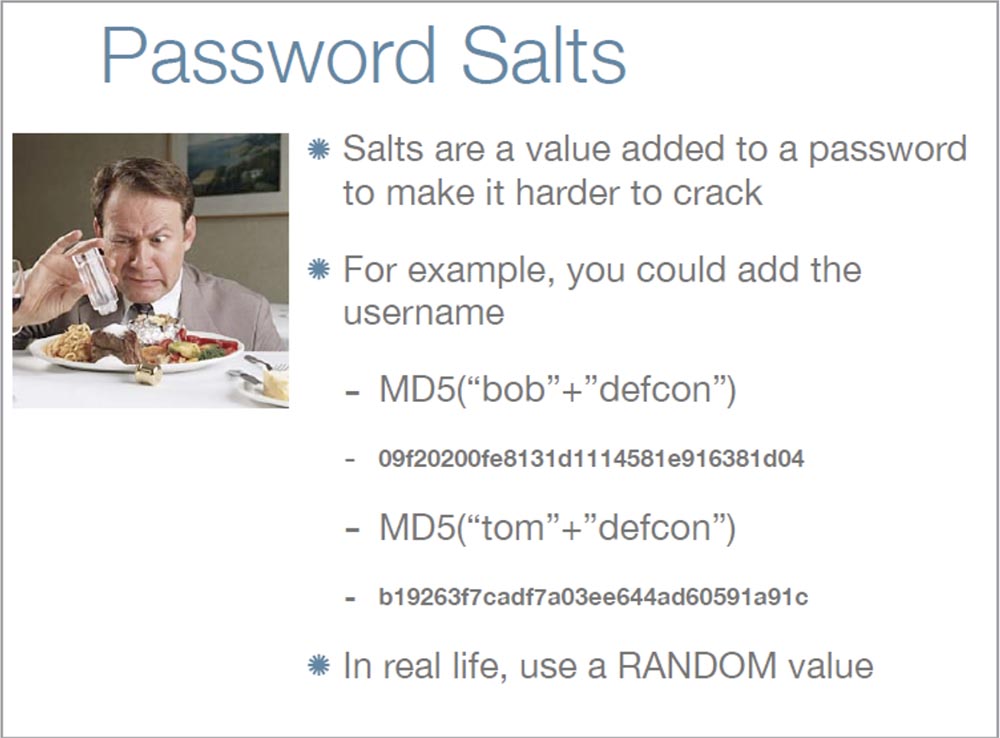
This is especially important for passwords that are stored on the network. Often, as a “highlight” , people add their own username to the microsoft password, but in reality this is a bad idea. Because the "raisins" also protect against attacks using the hash search. Usually, a hacker simply copies all password hashes at once, and if he needs to crack a password, he simply scans the stolen hash, and this happens very quickly. But if you use the "highlights", the hacker will not be able to do this until he hashes the hash of each specific user for the presence of "highlights" there.
Suppose that people have a “zest” for each microsoft password, then a hacker might not want to create a whole table with usernames. However, he knows that among them there can be a very popular name “administrator” , people are used to trusting him, so in this case a hacker can succeed.
Therefore, when creating "highlights" you need to consider such important things:
However, this method does not protect the user from attacks of a different kind, and you still have to think about how to make a password hash hack relatively expensive for a criminal.
And now let's go directly to the issue of password cracking.
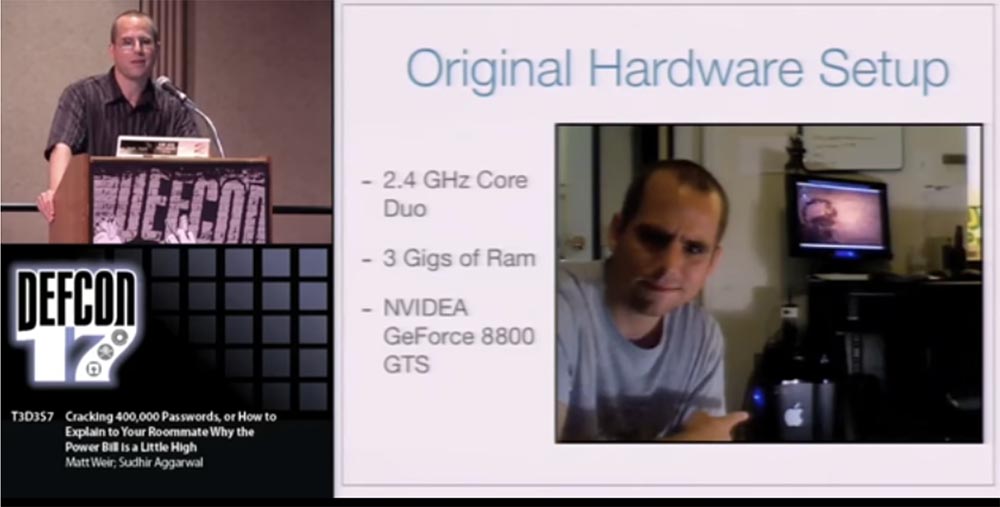
People usually ask me what kind of equipment I use when cracking passwords. I have a desktop computer with a 2.4 GHz dual-core processor, 3 GB of RAM and an NVidia GeForce 8800GTS video card , which is already 2 years old. This is not a special password cracking machine. I also use this MacBook a little bit. So all I have is 2 computers.
Unfortunately, after a couple of weeks of research, the electricity bill increased by 75%.
It’s hard to explain to your roommate when your computer’s coolers literally roar non-stop for the last 2 weeks. However, after I finished the work, the power consumption returned to normal.
Now almost all password cracking operations I spend on a computer in the institute laboratory. I used to use the generation of the RainbowCrack Table dictionary. When you hear people talking about you, like you have whole racks of something like Play Station 3 and a whole botnet for cracking passwords, I want to say: “you know, dude, I have just a laboratory Dell”. Therefore, when you consider threat modeling, it should be borne in mind that an attacker can definitely throw a lot more resources at that. For example, on hacking a site like phpbb.com . This is the phpbb software site . It was hacked on January 14, 2009, and this list was published on the Internet in early February. The attacker posted a lot of information about password hashes, site user names, e-mail accounts, as well as a very detailed description of the attack itself.
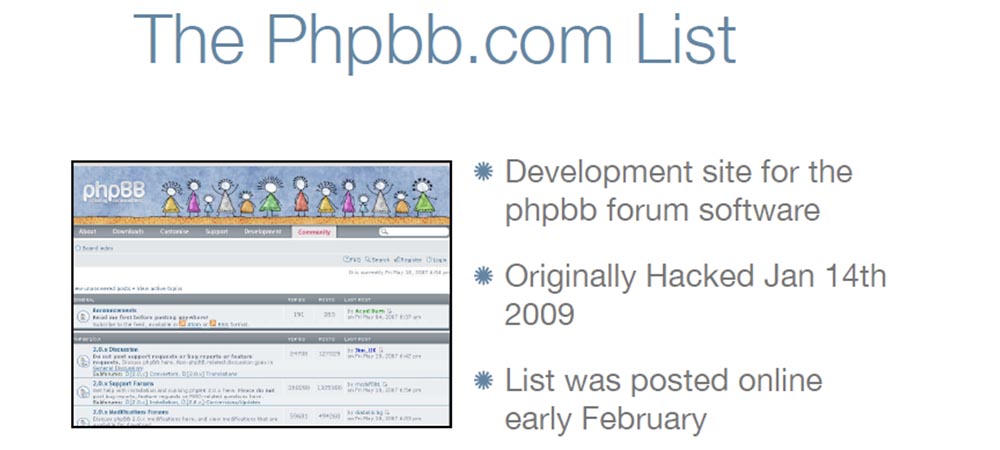
It was a pretty good “reading matter”, and the list itself contained about 259,000 MD5 hashes of passwords without “highlights” and 83,000 hashed passwords with “highlights”, which were created using the phpbb3 hashing algorithm . However, this is a new and rather rare algorithm, so in our research we only cracked passwords with traditional MD5 hashes. We excluded from consideration passwords with “zest”, because their hacking is too time consuming and we didn’t really understand it. Therefore, we focused on the MD5 password list. So passwords with "highlights" are protected much better, and any hacker would prefer to deal with something easier.
But I want to emphasize once again that if you are attacked and your password list is revealed, you still need to “cure” it and take the attack as a serious event, because the attacker could later use the result of his theft.
Next, we looked at the list of passwords for a hacked webhostingtalk site. For one or two weeks, the hacker used online password cracking, trying to hack about 117 thousand accounts. As a result, he managed to get 28,635 passwords, which accounted for 24% of the total. So, after analyzing the result, it can be said that even as a result of a powerful online attack, the hacker manages to crack no more than a quarter of all the passwords available.
Next, I will give a comparison of the effectiveness of online password hacking. The results are taken from the site http://www.hashkiller.com/ , most of them relate to Germany. But Babel Fish does much better - they not only have their own online password cracker forums, but they also track the performance of most other cracker communities. According to statistics, the success of online hacking is from 20 to 40% of all passwords that hackers have. There are MD5 hacker tools that collect hashes for online passwords from many sites. They can be downloaded from this link: http://sourceforge.net/projects/md5-utils/ . Currently there are 33 sites where these utilities can be used.
I want to warn you that there are serious privacy issues here, because if you think that those to whom you send password hashes will simply hold them for your collection, then you are a very gullible person.
Today there are several popular password cracking tools.

The most popular is John the Ripper , which is free software, and I recommend it first. But the main reason for its popularity, in which it is ahead of even paid programs, is the availability of open source code. If you want to crack passwords, this program will cope with everything you want. My favorite option in JtR is STDIN . If you remember the introductory slides, then in this case I don’t need to perform stage 1 and 2, I can write my own “guesswork” program, and then transfer the results to JtR . And he will decrypt the hashes and try to crack passwords. «», , , .
, . , , , , . , .
JtR Cain & Able ( ), . JtR , , , .
, JtR :
, . . , . DefCon , . , 95% MD5 , 2525 , , 2677 , . , .
, , 97%, . , , , . , .
«» , , , , 7,2 . 6% 1 % — , 51% . 5% , .
, . brute-force , . , . , , . , .
, , . , , . , – , brute-force . , «» . .
, Dictionary Attack , . « », , , , , 2 .
, Dictionary Attack . – «», , . , zibra123 , , zibra , . – , 123. , , .
, , , , .
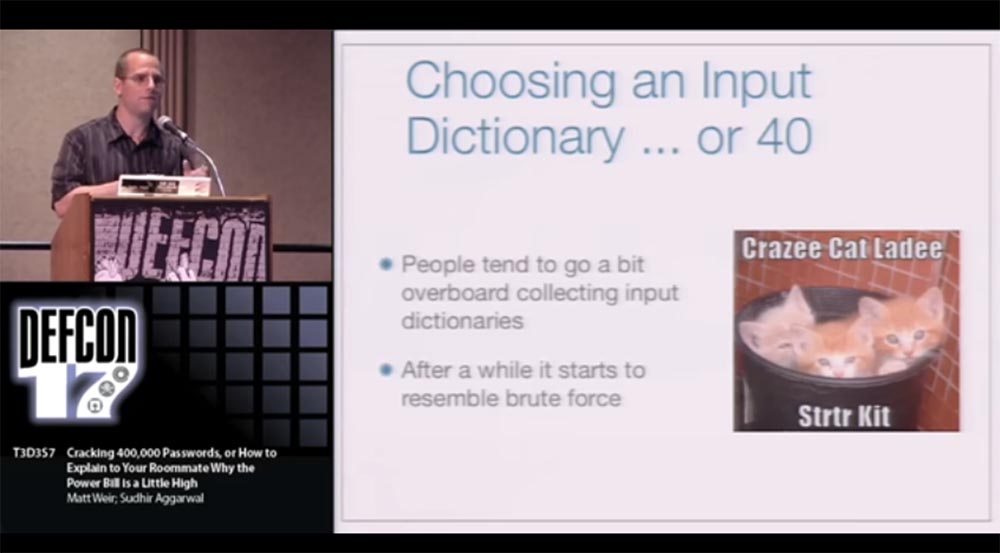
, input-. , brute-force . « », 50-60 , . , , , , «» . , — 1 40.
25:15
:
DEFCON 17. 400 000 , , . Part 2
Thank you for staying with us. Do you like our articles? Want to see more interesting materials? Support us by placing an order or recommending to friends, 30% discount for Habr users on a unique analogue of the entry-level servers that we invented for you: The whole truth about VPS (KVM) E5-2650 v4 (6 Cores) 10GB DDR4 240GB SSD 1Gbps from $ 20 or how to share the server? (Options are available with RAID1 and RAID10, up to 24 cores and up to 40GB DDR4).
VPS (KVM) E5-2650 v4 (6 Cores) 10GB DDR4 240GB SSD 1Gbps until December for free if you pay for a period of six months, you can order here .
Dell R730xd 2 times cheaper? Only we have 2 x Intel Dodeca-Core Xeon E5-2650v4 128GB DDR4 6x480GB SSD 1Gbps 100 TV from $ 249 in the Netherlands and the USA! Read about How to build an infrastructure building. class c using servers Dell R730xd E5-2650 v4 worth 9000 euros for a penny?

I really appreciate it, because this help has given my research some legitimacy. Because when I went to the scientific council to approve the topic of my research, I began the conversation with the fact that it was dedicated to cracking passwords. These words provoked an indignant reaction, so I had to explain that it was necessary in order, for example, to catch and bring to justice the molesters of minors and other such criminals.
')
Thus, the main purpose of my research is to help jurisprudence.
The law enforcement agencies are strong enough in encryption, so I was not going to help them with this, I just wouldn’t have enough brains for that. I decided to investigate the problems associated with attacks on users, because it is much easier than hacking complex ciphers. I wanted to develop a better model of how people create their passwords in real life, and then use it in an attack-resistant password strategy.
The first thing we need is to have an idea of how people create their passwords. We spent some time just to go online and find open password lists. They appear there for various reasons, for example, some hacker hacks the site and puts a list of user passwords to say to everyone: “look how cool I am”! We collected these passwords and analyzed.
There are many hackers forums, electronic bulletin boards and the like, where we also collected passwords. Now you rarely see simple text passwords, but this is a great thing, because all we have to do is just to find them and read them. However, most passwords are hashed, so in order to understand how people create them, we first need to crack them.
In fact, this is good for us, as it forces us to focus on practical goals. I mean, we just can’t just sit back and write research papers while drinking wine. We actually have to go ahead and try to apply what we got in our password lists, and check how it works. I was really interested in how to create an effective protection against hacking and to make passwords better, using more effective password creation strategies based on the knowledge gained from hacking.
I think it's much easier to hack something instead of fixing it. In this presentation I will try to avoid a detailed description of the tools and trifles I used. I'm not going to spend the next 50 minutes analyzing each command line of the J ohn the Ripper program, which serves to recover passwords for their hashes, or analyze page by page, how often people use sports team names as passwords. I do not want to waste your time.
If you are interested in details, you can visit my password-breaking blog www.reusablesec.blogspot.com or my website with my tools and documentation, which are freely available on the Internet at www.reusablesec.sites.google.com . Please leave your comments and feel free to say if you think we are doing something stupid. I really appreciate such comments, because this is the best way to evaluate the effectiveness of our work.
You also do not need to feverishly record anything or be afraid to skip some of the slides that flash on the screen, since this presentation is available on the conference CD, besides, you can download these slides from the Internet. I also recorded several additional tools on the disc. I’ll talk briefly about the tools used: this is our dictionary, created on the basis of the online version of RainbowCrack Tables , several password cracking scripts, analysis scripts that we used to analyze password lists and several user password lists we compiled.
It is noteworthy that we probably have the largest collection of single-line ASCII code encodings of passwords on the Internet. So you can say that my parents can be proud of me. I note that people create passwords even in this way, so that you can use it and hack them.

You can say, “Oh my God, passwords suck! Users are idiots, because they create stupid passwords, and in general, we are all doomed! ” Yes, I could spend time making fun of users, because it is fun, but not at all productive. I mean, we have known for many years that the fire is hot, the water is wet, that the user will simply choose a 1-2-3 password. This is not new. But we, as a security community, have to figure out what to do about it.
Not to say that I am an optimist, but I’m not too pessimistic about the future of passwords. I mean, we are “stuck” on these asterisks, which need to be filled in, and we will always use them, because they are really good.
There are many different factors that allow you to get rid of any "water", leaving only security. Password cracking becomes difficult, because people are beginning to use strong encryption, stronger password hashes, and passwords are more responsive to passwords. I think that is why there is such an interest in cracking passwords. I hope that Windows 7 will finally stick an aspen stake in the heart of XP , and we are starting to see fewer and fewer cases of using the WEP security algorithm for Wi-Fi networks, despite the fact that it is still quite widespread around. I mean, we should work on the problem of protecting passwords from hacking instead of destroying the existing system.
This approach will actually improve the situation, so I want to focus on what constitutes a password cracking session, what techniques are used and what steps need to be taken to crack password lists.
I want to focus on two different case studies. First of all, we created a password database for hacking using CISSP data - independent certification for information security. We collected many passwords everywhere, but these two sources, phpbb.com and webhostingtalk.com , were the best, because there were very large lists of passwords in the public domain.
Therefore, we first talk about hacking passwords from the phpbb.com list, and then about the results of hacking webhostingtalk.com . I will not arrange an introductory course in CISSP , because you know the language and terminology. After that, I will take a short break, and you can ask questions related to research using the TrueCrypt program, as well as talk about some passwords and non-standard passwords. So, let's talk about the basics of password cracking.

There are two different types of passwords and, accordingly, two ways to crack them, and they are very different from each other. The first is online passwords. You know from the films that you may not have access to the site at all if you do not know the password. Therefore, you are trying to get there by picking up various usernames and passwords. The main thing is that site creators try to protect themselves from hackers with the help of additional functions, for example, limiting the number of attempts to enter authorization data.
The second way is to hack offline passwords when you download a password hash and hack it on your computer. These are big problems in computer forensics, so you need to try to crack passwords before the police break in with an arrest warrant, kicking the door open with your feet. At the same time, they will remove the hard drive on which your program will be installed for hacking TrueCrypt along with cracked passwords. In addition, the cracking of passwords offline requires a very powerful computer and a lot of time.
In fact, after the attacker hacked the site and downloaded all the passwords and usernames, he is only limited by the time after which he can be caught.
The question is, why should a hacker crack passwords if he can just get full access to the site through a router. The answer is that people use the same password everywhere, so it's easier for you to access both email and bank account and PayPal account .
We did not do that. Having cracked passwords, we never used them for verification, for entrance on any site or in someone's account. I say this not because I believe that there are many federal agents in the audience here, but because this is really not good.
So, there are three different steps committed when a password is cracked. I want to differentiate them, because I will refer to them later. I had problems at each of these three stages.
The first stage concerns autonomous password cracking. Computer forensics assumes that you already have a password hash, in our case the entire hard disk of the computer was filled with this data. So, the first step you need to take is to try to guess what the user came up with for the password. To do this, you use the first attempt, suppose password123 . Then you hash it and get a set of letters and numbers 52F8A73082B1290 . In most cases, a simple and fast MD5 hashing algorithm is used . After that, you compare this set with your real user password hash, for example, 82503CA693453D1 . If it matched, you hacked the password. But since 52F8A73082B1290 ≠ 82503CA693453D1 , you try again and use the guess monkey123 . You repeat it again and again, until you get bored and you give up this thing.

Left: as encryption experts imagine.
“His laptop is encrypted.” Let's create a million dollar decoder and hack it! ”
“It won't go, it's a 4096-bit cipher!”
- "Heck! Our criminal plan failed. ”
Right: as it usually happens.
“His laptop is encrypted.” Wash him and beat him with a five-dollar wrench until he tells us the password! "
- "I agree"!
Let's talk about the "highlights" in the passwords. This information is added to the password to complicate its hacking. It happens that two different people decided to use the same password. In this case, for example, you can add different usernames to the “defcon” password, in which case the hashes will be very different from each other.

This is especially important for passwords that are stored on the network. Often, as a “highlight” , people add their own username to the microsoft password, but in reality this is a bad idea. Because the "raisins" also protect against attacks using the hash search. Usually, a hacker simply copies all password hashes at once, and if he needs to crack a password, he simply scans the stolen hash, and this happens very quickly. But if you use the "highlights", the hacker will not be able to do this until he hashes the hash of each specific user for the presence of "highlights" there.
Suppose that people have a “zest” for each microsoft password, then a hacker might not want to create a whole table with usernames. However, he knows that among them there can be a very popular name “administrator” , people are used to trusting him, so in this case a hacker can succeed.
Therefore, when creating "highlights" you need to consider such important things:
- this is not a secret. Well, if you keep the principle of creating "highlights" for passwords in secret, but first of all you need to ensure the security of the password itself;
- users do not need to know this. I do not mean that the user should not know that passwords are stored on the server, I mean that the "highlight" must be unique for each user;
- “Zest” will protect if an attacker targets only one user, and not a whole bunch of passwords. In this case, it prevents hash search attacks.
However, this method does not protect the user from attacks of a different kind, and you still have to think about how to make a password hash hack relatively expensive for a criminal.
And now let's go directly to the issue of password cracking.

People usually ask me what kind of equipment I use when cracking passwords. I have a desktop computer with a 2.4 GHz dual-core processor, 3 GB of RAM and an NVidia GeForce 8800GTS video card , which is already 2 years old. This is not a special password cracking machine. I also use this MacBook a little bit. So all I have is 2 computers.
Unfortunately, after a couple of weeks of research, the electricity bill increased by 75%.
It’s hard to explain to your roommate when your computer’s coolers literally roar non-stop for the last 2 weeks. However, after I finished the work, the power consumption returned to normal.
Now almost all password cracking operations I spend on a computer in the institute laboratory. I used to use the generation of the RainbowCrack Table dictionary. When you hear people talking about you, like you have whole racks of something like Play Station 3 and a whole botnet for cracking passwords, I want to say: “you know, dude, I have just a laboratory Dell”. Therefore, when you consider threat modeling, it should be borne in mind that an attacker can definitely throw a lot more resources at that. For example, on hacking a site like phpbb.com . This is the phpbb software site . It was hacked on January 14, 2009, and this list was published on the Internet in early February. The attacker posted a lot of information about password hashes, site user names, e-mail accounts, as well as a very detailed description of the attack itself.

It was a pretty good “reading matter”, and the list itself contained about 259,000 MD5 hashes of passwords without “highlights” and 83,000 hashed passwords with “highlights”, which were created using the phpbb3 hashing algorithm . However, this is a new and rather rare algorithm, so in our research we only cracked passwords with traditional MD5 hashes. We excluded from consideration passwords with “zest”, because their hacking is too time consuming and we didn’t really understand it. Therefore, we focused on the MD5 password list. So passwords with "highlights" are protected much better, and any hacker would prefer to deal with something easier.
But I want to emphasize once again that if you are attacked and your password list is revealed, you still need to “cure” it and take the attack as a serious event, because the attacker could later use the result of his theft.
Next, we looked at the list of passwords for a hacked webhostingtalk site. For one or two weeks, the hacker used online password cracking, trying to hack about 117 thousand accounts. As a result, he managed to get 28,635 passwords, which accounted for 24% of the total. So, after analyzing the result, it can be said that even as a result of a powerful online attack, the hacker manages to crack no more than a quarter of all the passwords available.
Next, I will give a comparison of the effectiveness of online password hacking. The results are taken from the site http://www.hashkiller.com/ , most of them relate to Germany. But Babel Fish does much better - they not only have their own online password cracker forums, but they also track the performance of most other cracker communities. According to statistics, the success of online hacking is from 20 to 40% of all passwords that hackers have. There are MD5 hacker tools that collect hashes for online passwords from many sites. They can be downloaded from this link: http://sourceforge.net/projects/md5-utils/ . Currently there are 33 sites where these utilities can be used.
I want to warn you that there are serious privacy issues here, because if you think that those to whom you send password hashes will simply hold them for your collection, then you are a very gullible person.
Today there are several popular password cracking tools.

The most popular is John the Ripper , which is free software, and I recommend it first. But the main reason for its popularity, in which it is ahead of even paid programs, is the availability of open source code. If you want to crack passwords, this program will cope with everything you want. My favorite option in JtR is STDIN . If you remember the introductory slides, then in this case I don’t need to perform stage 1 and 2, I can write my own “guesswork” program, and then transfer the results to JtR . And he will decrypt the hashes and try to crack passwords. «», , , .
, . , , , , . , .
JtR Cain & Able ( ), . JtR , , , .
, JtR :
- 4 – 38% ;
- 1 – 62% ;
- 1 1 – 89%;
- 98% , 95% MD5 .
, . . , . DefCon , . , 95% MD5 , 2525 , , 2677 , . , .
, , 97%, . , , , . , .
«» , , , , 7,2 . 6% 1 % — , 51% . 5% , .
, . brute-force , . , . , , . , .
, , . , , . , – , brute-force . , «» . .
, Dictionary Attack , . « », , , , , 2 .
, Dictionary Attack . – «», , . , zibra123 , , zibra , . – , 123. , , .
, , , , .

, input-. , brute-force . « », 50-60 , . , , , , «» . , — 1 40.
25:15
:
DEFCON 17. 400 000 , , . Part 2
Thank you for staying with us. Do you like our articles? Want to see more interesting materials? Support us by placing an order or recommending to friends, 30% discount for Habr users on a unique analogue of the entry-level servers that we invented for you: The whole truth about VPS (KVM) E5-2650 v4 (6 Cores) 10GB DDR4 240GB SSD 1Gbps from $ 20 or how to share the server? (Options are available with RAID1 and RAID10, up to 24 cores and up to 40GB DDR4).
VPS (KVM) E5-2650 v4 (6 Cores) 10GB DDR4 240GB SSD 1Gbps until December for free if you pay for a period of six months, you can order here .
Dell R730xd 2 times cheaper? Only we have 2 x Intel Dodeca-Core Xeon E5-2650v4 128GB DDR4 6x480GB SSD 1Gbps 100 TV from $ 249 in the Netherlands and the USA! Read about How to build an infrastructure building. class c using servers Dell R730xd E5-2650 v4 worth 9000 euros for a penny?
Source: https://habr.com/ru/post/422731/
All Articles